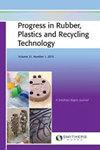再生HDPE、LDPE和PP的催化热解
IF 1.6
4区 材料科学
Q4 MATERIALS SCIENCE, COMPOSITES
Progress in Rubber Plastics and Recycling Technology
Pub Date : 2021-05-25
DOI:10.1177/14777606211019414
引用次数: 4
摘要
塑料垃圾每年都在增长,因此,环境问题一直是一个备受关注的话题。塑料的许多特性,如轻质、耐用和多功能性,是实现可持续发展的重要因素。塑料产量的指数增长每年产生大约1亿吨废塑料,这些废塑料可以通过采用一种适当称为热解的过程转化为碳氢化合物燃料。热解分为热热解和催化热解两种,不同的实验条件会影响产物的种类和数量。热解过程可以获得高附加值的产品,如燃料油和新产品的原料。本研究以硅酸镁(MgO3Si)和Cloisite 30B作为催化剂对不同的塑料进行分解,并与沸石催化剂的分解结果进行比较。以高密度聚乙烯(HDPE)为例,沸石催化剂的油收率为71%,而MgO3Si和Cloisite 30B的油收率分别为68%和67%。沸石对聚丙烯(PP)的分解效果优于MgO3Si和cloite 30B。采用傅里叶变换红外光谱(FTIR)和气相色谱(GC)进行分析。所有样品的光谱结果一致,且在燃料范围内。本文章由计算机程序翻译,如有差异,请以英文原文为准。
Catalytic pyrolysis of recycled HDPE, LDPE, and PP
Plastic waste has been growing every year, and as a result, environmental concern has been a topic of much attention. Many properties of plastics, such as their lightweight, durability, and versatility, are significant factors in achieving sustainable development. The exponential increase of plastic production produces every year approximately 100 million tons of waste plastic, which could be converted into hydrocarbon fuels by employing a process appropriately called pyrolysis. Pyrolysis, which is thermal or catalytical, can be performed under different experimental conditions that affect the type and amount of product obtained. With the pyrolysis process, products can be obtained with high added value, such as fuel oils and feedstock for new products. In this study, magnesium silicate (MgO3Si) and Cloisite 30B were used as catalysts for the decomposition of different plastics, and the results were compared with the zeolite catalyst. In the case of high-density polyethylene (HDPE), the oil yield with a zeolite catalyst was found to be 71%, whereas with MgO3Si and Cloisite 30B, this was 68% and 67%, respectively. Zeolite produced better results in the decomposition of polypropylene (PP) compared to MgO3Si and Cloisite 30B. Fourier-transform infrared spectroscopy (FTIR), and gas chromatography (GC) were conducted in this work. The spectra results for all samples were consistent and in the fuel range.
求助全文
通过发布文献求助,成功后即可免费获取论文全文。
去求助
来源期刊

Progress in Rubber Plastics and Recycling Technology
MATERIALS SCIENCE, COMPOSITES-POLYMER SCIENCE
CiteScore
4.40
自引率
7.70%
发文量
18
审稿时长
>12 weeks
期刊介绍:
The journal aims to bridge the gap between research and development and the practical and commercial applications of polymers in a wide range of uses. Current developments and likely future trends are reviewed across key areas of the polymer industry, together with existing and potential opportunities for the innovative use of plastic and rubber products.
 求助内容:
求助内容: 应助结果提醒方式:
应助结果提醒方式:


